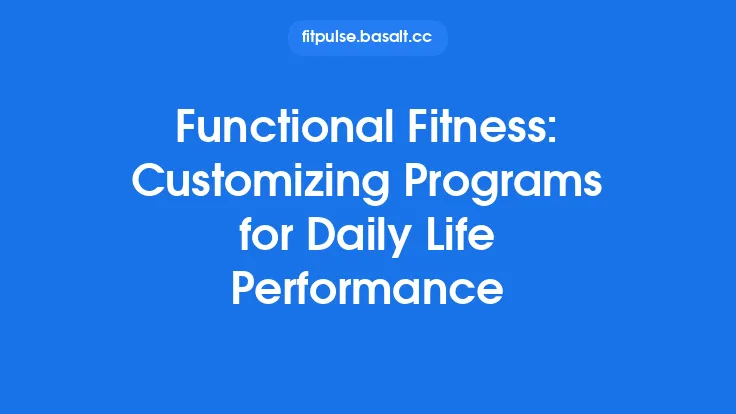Mobility is more than a collection of stretches; it is a dynamic, lifelong capacity that underpins functional movement, injury resilience, and overall quality of life. While the human body evolves dramatically from childhood through senior years, the principles that guide a well‑structured mobility program remain consistent: assess, plan, progress, and adapt. By applying a progressive, stage‑specific framework, practitioners, coaches, and individuals can cultivate a mobility regimen that grows with the body, respects its changing physiology, and aligns with the demands of each life phase.
Understanding the Foundations of Progressive Mobility
A progressive mobility program is built on three interlocking pillars:
- Specificity – Mobility work must target the joints, muscles, and movement patterns most relevant to an individual’s daily activities, sport, or occupational demands.
- Overload – Just as strength training requires a stimulus that exceeds the current capacity, mobility development necessitates gradually increasing range, control, or load to elicit adaptation.
- Recovery – Joint tissues, fascia, and neural pathways need adequate time to remodel. Over‑loading without sufficient recovery can lead to stiffness, inflammation, or compensatory movement patterns.
When these pillars are applied systematically, mobility improvements become predictable and sustainable, regardless of age.
Life‑Stage Considerations – Biological and Lifestyle Factors
| Life Stage | Primary Biological Traits | Lifestyle Influences | Mobility Implications |
|---|---|---|---|
| Youth (≈6‑18 yr) | Rapid musculoskeletal growth, high plasticity of neural pathways, open growth plates | School, extracurricular activities, variable sleep patterns | High capacity for learning new movement patterns; need to respect growth‑related joint laxity and avoid excessive compressive loads. |
| Adult (≈19‑64 yr) | Peak muscle mass (early adulthood), gradual decline in collagen elasticity, hormonal fluctuations | Work schedules, family responsibilities, sedentary periods | Mobility must counteract sedentary stiffness, support occupational biomechanics, and accommodate fluctuating stress levels. |
| Senior (≥65 yr) | Decreased collagen synthesis, reduced proprioceptive acuity, sarcopenia onset, comorbidities (e.g., osteoarthritis) | Retirement, reduced activity volume, medication effects | Emphasis on joint protection, functional range, and maintaining independence; progression must be highly individualized. |
Understanding these variables informs the selection of volume, intensity, and complexity for each stage’s program.
Designing a Periodized Mobility Program
Periodization—traditionally used in strength and endurance training—offers a roadmap for systematic mobility development. A typical annual cycle can be divided into four phases:
- Foundational Phase (4‑6 weeks)
Goal: Establish baseline joint range, movement quality, and neuromuscular control.
Approach: Low‑intensity, high‑frequency sessions (e.g., 5‑7 days/week, 5‑10 minutes per session) focusing on global patterns such as hip hinge, squat depth, and thoracic rotation.
- Progressive Load Phase (8‑12 weeks)
Goal: Introduce controlled overload through increased stretch duration, added external load (e.g., light bands, weighted sticks), or greater movement complexity.
Approach: Moderate frequency (3‑5 days/week) with sessions ranging 10‑20 minutes, integrating compound mobility drills that mimic daily tasks.
- Performance Integration Phase (6‑8 weeks)
Goal: Transfer mobility gains into sport‑specific or occupational movements.
Approach: Lower frequency (2‑4 days/week) but higher specificity, combining mobility with strength or skill work (e.g., overhead squat with a barbell, kettlebell windmills).
- Maintenance & Deload Phase (4‑6 weeks)
Goal: Consolidate adaptations, prevent regression, and allow systemic recovery.
Approach: Reduced volume (1‑3 days/week), focusing on “maintenance” ranges and active recovery modalities (e.g., dynamic flow sequences).
Each phase can be adjusted in length and intensity based on the individual’s age, baseline status, and goals. For example, seniors may spend a longer proportion of the year in the foundational and maintenance phases, while youth athletes can transition more quickly through progressive load phases due to higher tissue plasticity.
Assessment and Baseline Metrics for Each Age Group
Accurate assessment is the cornerstone of any progressive program. While the specific tools may differ across life stages, the core metrics remain consistent:
| Metric | Youth | Adult | Senior |
|---|---|---|---|
| Joint Range of Motion (ROM) | Goniometer or inclinometer; focus on growth‑related asymmetries | Standard ROM tests; compare to normative data for age and sex | ROM with pain rating; prioritize functional ranges (e.g., sit‑to‑stand) |
| Movement Quality | Functional Movement Screen (FMS) or pediatric equivalents; emphasis on motor control | Dynamic movement screens (e.g., squat, lunge, overhead reach) | Timed Up‑and‑Go (TUG), sit‑to‑stand, and balance assessments |
| Tissue Compliance | Myotonometry or simple palpation for muscle tone | Myotonometry, ultrasound elastography (if available) | Ultrasound elastography, skinfold thickness for fascial health |
| Neural Adaptability | Reaction time tests, simple coordination drills | Proprioceptive tests (e.g., joint position sense) | Balance platform or sway analysis |
These assessments should be repeated at the end of each periodization phase to quantify progress and inform subsequent programming decisions.
Progression Strategies for Youth
Youth bodies are uniquely responsive to motor learning, yet they also demand safeguards to protect growth plates and developing connective tissue. Effective progression for this stage blends skill acquisition with controlled overload:
- Complexity Ladder: Begin with single‑plane movements (e.g., hip flexion) and advance to multi‑plane, multi‑joint patterns (e.g., rotational lunges) as coordination improves.
- Load Modulation: Introduce light external resistance (e.g., PVC pipes, resistance bands) only after the athlete demonstrates consistent technique and adequate joint stability.
- Time‑Under‑Tension (TUT): Gradually increase the duration of each stretch from 10 seconds to 30 seconds, ensuring the child can maintain relaxed breathing throughout.
- Frequency Tweaking: Start with daily short sessions; as proficiency grows, shift to 4‑5 days per week with slightly longer bouts to promote tissue remodeling without over‑stress.
A key nuance is to align mobility goals with sport or activity demands. For a young gymnast, emphasis may be placed on shoulder and hip external rotation, whereas a youth soccer player benefits from ankle dorsiflexion and hip internal rotation work. The progression should always be framed within the context of the child’s primary movement environment.
Tailoring Mobility for Adults – Balancing Work, Recovery, and Longevity
Adults often juggle professional obligations, family responsibilities, and varying levels of physical activity. A progressive mobility program for this demographic must be time‑efficient, integrated, and adaptable:
- Micro‑Sessions: Embed 5‑minute mobility bursts into work breaks (e.g., desk‑based thoracic extensions, hip flexor mobilizations) to counteract prolonged sitting.
- Load‑Based Progression: Use weighted implements (e.g., kettlebell overhead carries) to increase joint loading once baseline ROM is achieved, thereby stimulating collagen synthesis and joint capsule strengthening.
- Periodized Stress Management: Align higher‑intensity mobility phases with lower work stress periods (e.g., post‑vacation) to ensure adequate recovery.
- Functional Prioritization: Focus on movement patterns that support daily tasks—hip hinge for lifting, shoulder external rotation for reaching, ankle dorsiflexion for stair navigation.
Adults also benefit from cross‑training: integrating mobility work with strength, cardio, and flexibility sessions creates a holistic stimulus that promotes joint health while supporting overall fitness goals.
Senior Mobility – Emphasizing Functional Independence and Adaptive Progression
For seniors, the primary objective of mobility training is to preserve or enhance functional independence—the ability to perform activities of daily living (ADLs) safely and efficiently. Progressive programming for this stage incorporates several distinct considerations:
- Pain‑Guided Progression: Use a numeric pain scale (0‑10) to dictate load and range; any increase beyond a 2‑point rise should trigger a regression.
- Joint Protection Strategies: Emphasize eccentric control and isometric holds to strengthen peri‑articular musculature without imposing high compressive forces.
- Adaptive Load: Incorporate light external resistance (e.g., 1‑2 kg dumbbells) only after the senior demonstrates stable joint control and minimal discomfort.
- Functional Benchmarks: Progress mobility based on ADL performance metrics (e.g., ability to rise from a chair without assistance, reach overhead to retrieve an object).
- Frequency Adjustments: Opt for daily low‑dose mobility work (5‑10 minutes) rather than high‑intensity sessions, allowing for consistent stimulus while respecting slower tissue remodeling rates.
A senior’s program should also integrate balance and proprioceptive drills as part of the mobility progression, given the interdependence of joint range and postural stability in this age group.
Cross‑Stage Integration – Transitioning Between Life Stages
Life is not compartmentalized; the end of one stage naturally flows into the next. A well‑designed progressive mobility framework anticipates these transitions:
- Youth → Adult: As growth plate closure occurs (≈18‑20 yr), shift emphasis from pure flexibility to strength‑enhanced mobility. Introduce moderate loads and longer TUT to support musculoskeletal maturity.
- Adult → Senior: Around the mid‑40s, begin incorporating maintenance phases that prioritize joint health over maximal range. Gradually increase focus on functional ranges relevant to ADLs.
- Senior → Advanced Age: For individuals entering their 80s+, prioritize micro‑mobility (small, controlled movements) and pain‑free ranges, while maintaining a consistent stimulus to prevent rapid decline.
By embedding transition checkpoints—annual reassessments that compare current metrics to age‑appropriate norms—practitioners can smoothly adjust program variables, ensuring continuity of progress without abrupt jumps that could increase injury risk.
Monitoring, Feedback, and Adjustments Using Technology
Modern wearable and digital tools can enhance the precision of progressive mobility programs:
- Inertial Measurement Units (IMUs): Track joint angles in real time, providing objective data on ROM improvements and identifying asymmetries.
- Force‑Sensitive Platforms: Measure ground reaction forces during mobility drills, offering insight into load distribution and compensatory patterns.
- Mobile Apps with Video Analysis: Allow users to record sessions, overlay anatomical landmarks, and receive algorithm‑driven feedback on movement quality.
- Cloud‑Based Dashboards: Aggregate data across weeks, enabling practitioners to visualize trends, adjust periodization phases, and communicate progress to clients.
When employing technology, it is crucial to interpret data within the context of the individual’s subjective experience—pain levels, perceived effort, and functional outcomes remain paramount.
Nutrition, Sleep, and Lifestyle Synergy with Mobility
Mobility adaptations are not isolated to the musculoskeletal system; they are profoundly influenced by systemic factors:
- Protein Intake: Adequate amino acids (≈1.2‑1.6 g/kg body weight for active adults, slightly higher for seniors) support collagen synthesis and muscle repair, facilitating joint health.
- Micronutrients: Vitamin C, zinc, and copper are essential cofactors for collagen cross‑linking; deficiencies can impair tissue remodeling.
- Hydration: Synovial fluid viscosity is hydration‑dependent; adequate water intake ensures optimal joint lubrication during mobility work.
- Sleep Quality: Deep sleep stages (especially slow‑wave sleep) drive growth hormone release, which is critical for tissue repair and remodeling. Aim for 7‑9 hours per night, with consistent sleep hygiene practices.
- Stress Management: Chronic cortisol elevation can degrade connective tissue; incorporating mindfulness or low‑intensity aerobic activity can mitigate this effect.
Integrating these lifestyle pillars with a progressive mobility program creates a holistic environment that maximizes adaptation and sustains long‑term joint health.
Common Pitfalls and How to Avoid Them
| Pitfall | Why It Happens | Corrective Strategy |
|---|---|---|
| Over‑emphasis on static stretching | Misconception that longer holds equal faster gains | Blend static holds with dynamic, loaded, and functional mobility drills. |
| Neglecting movement quality | Focus on “how far” rather than “how well” | Prioritize motor control assessments; regress if compensations appear. |
| One‑size‑fits‑all programming | Desire for simplicity or lack of assessment data | Conduct individualized baseline testing; adjust volume/intensity per age stage. |
| Skipping recovery | Belief that more is always better | Schedule deload weeks; monitor soreness and joint discomfort. |
| Ignoring pain signals | “No pain, no gain” mindset | Use pain scales; regress or modify when pain exceeds a 2‑point increase. |
| Inconsistent frequency | Busy schedules or lack of habit formation | Implement micro‑sessions and habit‑stacking (e.g., mobility after brushing teeth). |
By recognizing and proactively addressing these common errors, practitioners can maintain program integrity and ensure sustainable progress across the lifespan.
In sum, a progressive mobility program that respects the physiological nuances of youth, adult, and senior life stages can serve as a cornerstone for lifelong functional health. Through systematic assessment, periodized planning, age‑appropriate progression, and integration of technology and lifestyle factors, mobility can be cultivated not as a fleeting fitness trend but as an enduring, adaptable capacity that supports every movement we make—from playground games to workplace tasks, and from daily chores to cherished moments with loved ones.





